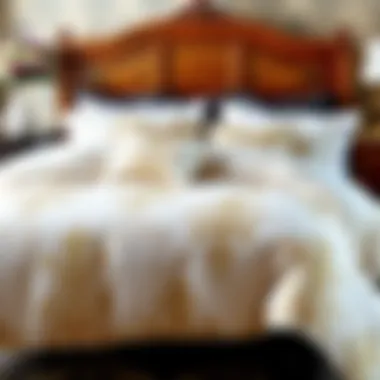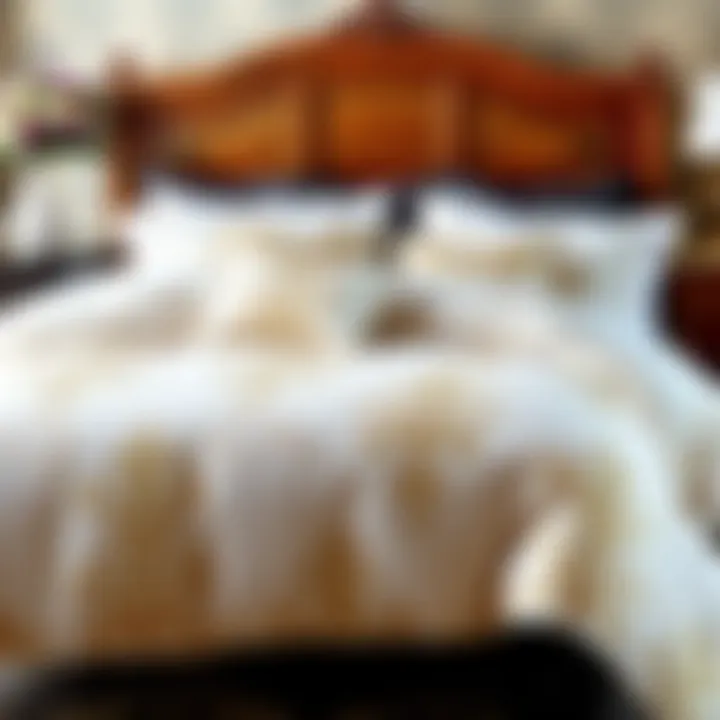Guide to Choosing Full Size Bed Comforter Sets


Intro
In the realm of home decor, the choice of bedding often goes unnoticed, yet it plays a crucial role in defining the atmosphere of a bedroom. Full size bed comforter sets are more than just a protective layer; they serve as a statement piece, infusing style and comfort into personal spaces. By selecting the right comforter set, homeowners can effortlessly elevate their bedrooms, making them inviting sanctuaries.
This guide takes a closer look at full size comforter sets, offering insights into styles, materials, and the practicalities of selecting the ideal set that complements one’s decor while providing warmth and comfort. With a sharper focus on current trends, maintenance advice, and common misconceptions, this exploration ensures that readers are well-equipped to make informed choices.
Furniture Styles and Trends
Modern vs. Traditional: Understanding the Key Differences
When it comes to comforter sets, the choice between modern and traditional styles significantly influences overall aesthetics. Modern designs typically feature clean lines and minimalist patterns, often leaning towards neutral color palettes. Think geometric prints, solid colors, and sleek textures that convey a sense of sophistication without overwhelming the senses.
In contrast, traditional styles are characterized by rich textures and ornate patterns. Floral designs, intricate embroidery, and warm, inviting hues make these sets feel luxurious and classic. They often invoke a sense of nostalgia, reminding one of timeless elegance.
Adapting the correct style to the bedroom isn’t solely about personal preference. Considering the existing decor is essential. For example, a contemporary room filled with minimalist furniture might clash with a heavy, ornate comforter set.
Top Comforter Trends to Watch in
As we embrace 2023, certain trends in full size bed comforters have emerged prominently:
- Natural Fabrics: Linen and cotton are gaining momentum, as people become more conscious of material sources and the environment.
- Textured Layers: Layering varying textures can add depth and complexity to bedding setups. Imagine pairing a smooth comforter with a chunky knit throw.
- Bold Patterns: From oversized florals to abstract art motifs, bold patterns are making their mark as homeowners seek to express individuality.
- Earthy Tones: As we move away from bright accents, a shift towards earthy colors like terracotta and forest greens can be seen, creating a calm atmosphere.
Adapting these trends not only keeps the bedroom in vogue but also allows one to create a space that feels personal and reflective of current aesthetics.
Practical Tips for Comforter Selection
How to Choose the Right Comforter for Your Space
Selecting the right comforter set goes beyond aesthetics. It involves analyzing several factors:
- Size Matters: Ensure the comforter fits the full bed properly. A comforter that is too small might leave unappealing gaps.
- Climate Considerations: Think about your local weather. For warmer zones, lightweight materials are best, while heavier, insulated options are ideal for colder climates.
- Allergies and Sensitivities: Those with sensitivities may prefer hypoallergenic materials, while others might seek out moisture-wicking fabrics for added comfort.
Sustainable Choices: Tips for Eco-Friendly Options
Being environmentally conscious is more than a trend; it's a lifestyle choice. Here are ways to opt for sustainable comforter sets:
- Organic Materials: Look for cotton or linen marked as certified organic to consciously reduce chemical exposure.
- Recycled Materials: Some brands offer comforters made from recycled plastics, turning waste into something comfortable.
- Durability: Opt for high-quality products that are built to last. Investing in durability means less waste over time.
"In our quest for comfort, never forget the impact choices have on our surroundings."
Understanding Full Size Bed Comforter Sets
In the realm of home decor, few things are as pivotal as the right bedding. Full size bed comforter sets play a crucial role not just in aesthetic appeal, but in enhancing the overall comfort of a bedroom. As we delve into this topic, it's essential to recognize the intricate relationship between comfort, style, and functionality. This exploration is not merely about choosing a comforter; it’s about understanding how these sets contribute to the atmosphere of your personal space.
Defining Comforter Sets
A comforter set usually encompasses several components that work in harmony to create a cohesive look for your bed. At its core, a comforter is a thick, woven fabric blanket filled with materials like down, polyester, or other insulating fibers. It is designed to keep you warm during colder months or to provide a soft, cushioned feel for cozy nights. Generally, these sets include a comforter, shams that match, and sometimes additional items like decorative pillows or a bed skirt.
Choosing a comforter set is akin to assembling a puzzle; every piece must fit both in vibe and dimensions. It’s not just about aesthetics, though enjoying a well-coordinated bedroom visually can be beneficial. The comforter set should reflect your personality and align with the overall decor theme, whether that be modern minimalism or rustic charm.
Importance of Size in Comforters
How size factors into comforters cannot be overstated. A full bed is not the same as other bed sizes, so understanding dimensions is crucial for achieving that perfect fit. Opting for a larger or smaller comforter can drastically affect the look and feel of your bedding setup. A comforter that’s too small may leave naked patches of mattress visible, detracting from the look you've worked to achieve. On the flip side, one that's overly large can overwhelm the space, cloaking your aesthetic in an unintentional chaos.
Furthermore, the weight and warmth offered by various sizes might impact your sleep quality. Choosing the right size means finding a balance between coziness and practicality. Not to be overlooked, proper sizing ensures longevity; a well-fitted comforter experiences less wear and tear and maintains its shape more effectively, giving you better value for your investment.
"A properly sized comforter not only enhances visual appeal but also plays a pivotal role in your quality of sleep."
Components of a Comforter Set
When considering the perfect full-size bed comforter set, it's essential to focus on the individual components that make up the ensemble. Each piece plays a unique role in the functionality and aesthetic of the bedding, ensuring not only comfort but also visual appeal. Understanding these components can vastly improve your selection process, guiding you towards options that suit both your practical needs and design preferences. Let's dive into the core elements of a comforter set and their importance.
Comforter
The comforter is undeniably the star of the show. It's the piece that brings warmth and a solid layer of coziness to your bed. Often filled with materials like down or synthetic fibers, a comforter serves the primary purpose of keeping you snug during chilly nights. However, beyond mere warmth, the comforter contributes significantly to the overall look of your bedroom.
Many comforter sets feature unique designs—be it floral patterns, geometric shapes, or even abstract art—that can tie together your room’s color scheme. Choosing a comforter that aligns with your aesthetic is crucial.


Features to consider:
- Material: Cotton comforters are breathable, while polyester options might offer durability and stain resistance.
- Weight: Selecting a lightweight option for summer or a heavyweight one for winter can make all the difference in comfort.
Shams
Shams are the decorative pillow covers that accentuate the comforter. While they might seem like simple extras, they play a pivotal role in elevating the elegance of your bedding arrangement. Available in numerous sizes and styles, shams can transform a basic setup into something visually compelling.
Considerations include:
- Fabric: Just like with comforters, materials matter. Silk shams offer a luxurious look, while cotton provides a classic and approachable option.
- Patterns: Shams should complement the comforter or add a contrasting pop of color, adding depth to the entire set.
Bed Skirt
Often overlooked, the bed skirt can be a game-changer in how your bed looks. This component provides a seamless transition between the mattress and the floor, hiding any under-bed storage while adding a touch of refinement. Bed skirts are typically pleated or ruffled, presenting options that vary widely in style.
Key thoughts on bed skirts:
- Functionality: They not only cover the unsightly dust bunnies but also contribute to insulation by blocking drafts from underneath the bed.
- Design compatibility: A color that echoes the comforter or introduces an intriguing new tone can act as an invitation to explore the room further.
Decorative Pillows
Finally, decorative pillows are like the cherry on top of a sundae. They serve as an accent piece, providing an opportunity for personal expression. Whether you choose textured pillows, those with fun patterns, or even playful shapes, they can bring life and character into the space.
When selecting decorative pillows:
- Variety in Size: Incorporating different sizes creates visual interest.
- Material Mix: Combine different fabrics for a textured look that invites touch.
"A well-composed bed is like a well-composed symphony, where every element contributes to the harmony of the ensemble."
In summary, understanding these components—comforters, shams, bed skirts, and decorative pillows—allows homeowners and designers alike to construct not just a bed, but a striking centerpiece that resonates through the whole room design. Choosing the right comforter set inherently involves knowing how these elements work in tandem to provide both comfort and style.
Choosing the Right Comforter Set
Choosing the right comforter set is a game changer when it comes to transforming your bedroom into a cozy retreat. It's not just about the colors and styles; the choice you make can greatly influence your comfort and well-being. A well-selected comforter can enhance sleep quality and align with your aesthetic preferences, while the wrong one can lead to discomfort and dissatisfaction. Given that this is often a central piece in your bedroom, making an informed decision here will affect not only your decor but also your daily life.
Fabric Considerations
Natural Fabrics
Natural fabrics are commonly preferred due to their breathable qualities. Cotton, linen, and bamboo are a few examples. These materials are hypoallergenic, reducing the risk of allergic reactions. One key characteristic of natural fabrics is that they tend to feel comfortable against the skin, which makes them a popular choice for many homeowners.
However, these fabrics can require more care; for instance, they may shrink when washed in high temperatures. It's essential to follow the washing guidelines to prevent damage. Their durability can also vary, where cotton may last years, while linen might fray sooner.
Synthetic Fabrics
Synthetic fabrics like polyester and microfiber offer their own set of benefits. They're often cheaper, more resistant to stains, and can wick moisture away from the body. The key characteristic that makes synthetic fabrics appealing is their affordability and ease of maintenance.
Though they are less breathable than natural options, they can be a great choice for those who want to keep costs low and don't mind sacrificing some comfort for durability. However, some people might find these fabrics too hot, especially in warmer climates.
Blends
Bed sets featuring blended fabrics combine the benefits of both worlds. A common blend is polyester cotton, which brings together the softness of cotton with the durability of polyester. This blend can enhance longevity while maintaining a comfortable feel—a balanced choice for many.
While blends facilitate easier care and are often less prone to wrinkles, they might not always provide the same level of breathability as pure cotton. Each mix can vary greatly, so checking the fabric composition is key to making an informed decision.
Color and Pattern Selection
Solid Colors
Solid colors often create a calming environment. They can easily complement various decor styles and are sometimes easier to match with existing bedroom accessories. This simplicity can translate to a more cohesive look, which allows one to experiment with vibrancy through other elements like pillows or artwork.
On the other hand, solid colors may lack the excitement that patterns can provide. They can be perceived as less engaging than the more visually stimulating options, making it essential to balance solids with other adornments if they're your primary choice.
Patterns and Prints
Patterns and prints offer a fun and lively touch to your bedding. Floral, geometric, and abstract designs can bring personality and character to your bedroom. They can often play a considerable role in setting the mood of the space.
Nevertheless, too many patterns can create a busy look, potentially overwhelming a room. Pairing a patterned comforter with solid-colored decor can achieve an excellent balance, allowing for a stylish yet comfortable atmosphere.


Seasonal Themes
Seasonal themes not only keep your bedroom feeling fresh, but they can also evoke emotions tied to time of year. Decorative options like autumn leaves, winter snowflakes, summer florals, or spring pastels breathe life into spaces as they reflect nature's colors.
However, seasonal themes may require changing out your comforter several times a year. This might not be feasible or practical for everyone. For those who relish variety, this could be an exciting way to transform their surroundings.
Warmth and Weight
Lightweight Options
Lightweight options excel in warmer conditions or for those who easily overheat. They provide just enough coverage without making you feel like you’re buried under a mountain of fabric. Typically made from thin materials, they are easy to handle and machine wash.
Yet, the downside is that they may not provide enough warmth during colder months, requiring extra blankets, which could be inconvenient.
Medium Weight
Medium-weight comforters provide a nice balance between comfort and warmth. They typically work well for year-round use, making them a versatile choice. This type is often thick enough to keep you cozy, but without the bulk of heavier options.
While they suit a broader range of climates, folks in especially cold areas may still find them lacking on particularly frigid nights.
Heavyweight Choices
Heavyweight choices are ideal for cold climates or those who favor a snug feel. They wrap around you like a warm hug, providing that cozy sanctuary you might be searching for during winter. Often quilted for added warmth, these options usually feature high-density filling.
On the downside, heavyweight comforters can feel cumbersome and hot in more temperate conditions. This can discourage their year-round use.
In considering these various aspects, it becomes clear that each element—from fabric and design to warmth and weight—requires careful thought to match not just your style but also your lifestyle needs.
Popular Styles of Full Size Bed Comforter Sets
In the world of interior design, comforter sets represent not just warmth and functionality, but also an expression of one’s style and personality. The choices available can be as varied as a buffet table at a family reunion, catering to a wide array of tastes and preferences. Understanding popular styles of full size bed comforter sets is essential for anyone looking to strike that balance between aesthetics and comfort in their bedroom. Here, we'll explore different categories, each with its unique flair and virtues, guiding you towards the perfect match for your space.
Modern Aesthetics
Modern comforter sets encapsulate clean lines, bold colors, and minimalistic patterns. The emphasis is on simplicity that doesn’t sacrifice style. These sets often utilize materials that not only provide comfort but also enhance the overall ambiance of a room. Think of fabrics that sport geometric shapes or monochromatic palettes.
When selecting a modern comforter, consider the following elements:
- Color Palette: Neutral tones with splashes of vibrant colors can create a stunning contrast.
- Textures: Look for innovative fabrics that add subtle depth and dimension, such as a plush faux fur or a crisp cotton blend.
- Functionality: Modern aesthetics often marry form and function seamlessly, allowing for easy maintenance and practicality.
Traditional Designs
For those who have a penchant for nostalgia, traditional designs in comforter sets evoke a sense of comfort and familiarity. These styles often feature floral patterns, classic plaids, or intricate embroideries. The fabrics used are usually rich and inviting, such as damask or heavy cotton.
Characteristics to note in traditional comforter sets include:
- Patterns: Timeless floral or paisley designs appeal to those wanting a homey feel.
- Materials: Heavier fabrics provide warmth and are often layered to offer a more luxurious appearance.
- Color Shades: Earth tones and soft pastels often dominate, inviting a calm atmosphere into the room.
Eclectic Combinations
Eclectic comforter sets are like a delightful mix-tape of styles. They are perfect for those who refuse to be boxed into one category. These sets often blend bold patterns with various textures, drawing inspiration from global design trends. Think of a comforter set that incorporates bright tribal prints paired with sleek modern pillows.
When exploring eclectic options, keep these points in mind:
- Variety of Patterns: Combining different prints, like stripes with florals, creates visual interest.
- Color Fusion: Embrace a riot of colors, but ensure they complement each other without being jarring.
- Textural Play: Mixing materials such as linen with velvet can elevate the comfort and style.
Minimalist Choices
Minimalism is about decluttering not just your space but also your mind. Comforter sets in this style focus on essential elements, steering clear of excessive patterns and colors. These sets are characterized by their simplicity and functionality, often in soft, muted shades.
Key facets of minimalist comforters include:
- Simplicity in Design: Solid colors or a subtle gradient help in maintaining a peaceful aura in the bedroom.
- Efficient Use of Space: These sets often come in lightweight materials allowing for easy storage and shifting.
- Streamlined Aesthetics: The focus is on creating a serene space that promotes relaxation.
"Choosing your comforter set could very well be the difference between a relaxing retreat and a chaotic clutter!"
With so many styles to choose from, homeowners, designers, and even students can find a full size bed comforter set that meets their needs and suits their tastes. Each style caters to different sensibilities, so it's worth taking the time to explore what resonates most with you.


Eco-Friendly Options
When it comes to selecting a comforter set, more homeowners and designers are searching for eco-friendly options that not only add style to their bedroom but also reflect a commitment to sustainability. The shift towards environmentally friendly products signifies an increasing awareness about the impact that textiles have on our planet. It’s not just about having something nice on your bed; it’s about making choices that are better for the earth and ourselves.
Sustainable Fabrics
Sustainable fabrics play a crucial role in the realm of bedding. They are usually derived from resources that are renewable, recycled, or produced with minimal impact on the environment. Common materials include organic cotton, bamboo, and linen. Each of these fabrics has its own set of benefits.
- Organic Cotton: Free from harmful pesticides and chemicals, this material feels soft against the skin and is biodegradable. It’s a fine option for those with allergies or sensitive skin.
- Bamboo: Known for its antimicrobial properties, bamboo is perhaps nature's wonder fabric. It grows rapidly and requires less water than cotton, making it a promising alternative.
- Linen: Harvested from flax plants, linen is both durable and biodegradable. Its natural breathability can help maintain a comfortable sleeping environment, especially in warmer climates.
The choice of fabric significantly affects not just comfort but also longevity. Natural fibers tend to age beautifully, standing the test of time while contributing to less waste in the long term.
Ethical Production Practices
Alongside sustainable materials, it’s vital to consider the production practices behind comforter sets. Ethical production ensures that workers are treated fairly and that the manufacturing processes do not harm the environment. There are several factors to consider here:
- Fair Trade Certification: Brands that are Fair Trade certified often uphold better labor practices and offer fair wages to their workers. This is a mark of quality and integrity.
- Local Sourcing: Comforters made from locally sourced materials have a lower carbon footprint since they require less transportation.
- Eco-Friendly Manufacturing Processes: Techniques that minimize water use, reduce energy consumption, and avoid toxic chemicals contribute to a smaller environmental impact.
"Making a conscious decision to choose eco-friendly options not only benefits personal health but also plays a part in promoting an ethical economy and helping the planet."
Investing in comforter sets that prioritize sustainability and ethical practices is increasingly becoming a standard for conscientious consumers. When choosing a full-size bed comforter set, reflecting on these aspects can lead to a better night's sleep both for you and for the earth.
Caring for Your Comforter Set
Caring for your comforter set is essential to not only enhance its aesthetic value but also to prolong its lifespan. A well-maintained set can transform your bedroom into a haven of comfort and style. In this section, we’ll dive into the nitty-gritty of proper care, which includes washing guidelines and effective storage strategies.
Washing Guidelines
Keeping your comforter set clean involves more than just tossing it in the washing machine. Each fabric type requires a specific approach to ensure it retains its beauty and functionality.
- Check the Label: Every comforter comes with a care label. Ignoring this can lead to unintentional damage. Standard instructions often recommend cold water settings and gentle cycles to prevent shrinking or fading.
- Choose the Right Detergent: A mild detergent works wonders on delicate fabrics. Strong chemicals may degrade the fabric fibers over time, so it’s a good idea to go easy on the soap.
- Consider Professional Cleaning: For high-end or intricate designs, professional cleaning may be the best choice. They know how to handle delicate materials, plus it's less hassle on your part.
- Drying Tips: When it's time to dry, avoid high heat as it can lead to shrinkage. Instead, use a low heat setting, or better yet, air dry if you have the patience.
"A clean comforter is not just about appearance; it can significantly impact your sleeping environment and, ultimately, your well-being."
Storage Tips
Proper storage is just as important as cleaning. When it comes time to stow away your comforter, follow these guidelines to keep it in top shape:
- Use Breathable Storage Bags: Plastic bags may seem convenient, but they trap moisture. Instead, opt for cotton or linen storage bags that allow air circulation.
- Avoid Compression: Don’t squish your comforter into tight spaces. This can lead to permanent creases or damages. Store it flat if possible, or loosely folded, to maintain its loft.
- Keep It In a Cool, Dry Place: Choose a storage area that’s free from humidity and extreme temperatures. A closet away from direct sunlight will help prevent fading and deterioration.
- Include Silica Gel Packs: Adding silica gel packs to your storage can help absorb any moisture and prevent mold or mildew from forming.
Caring for your comforter isn’t just about aesthetics; it’s key to maximizing comfort and durability over time. Each time you envelop yourself in that cozy comforter, take pride in knowing you’ve put in the effort to keep it looking and feeling its best.
Common Misconceptions
When it comes to selecting full size bed comforter sets, many individuals carry with them a pack of assumptions that may lead to less than ideal choices. Understanding these misconceptions is crucial for making informed decisions. It helps consumers navigate the market, ensuring that both comfort and aesthetics are prioritized. Sometimes, what seems to be a simple choice can veer off course when fueled by misunderstandings. Below, we tackle two prevalent misconceptions that often cloud judgment when selecting the ideal comforter set for your space.
Overestimating Warmth
One common misconception involves the perception of warmth associated with different comforter materials. Many shoppers tend to assume that a thicker comforter automatically means it will be warmer. However, this isn’t necessarily the case. The insulation qualities vary significantly depending on the material used, not just the thickness. For instance, a down comforter can be light yet provide warmth that rivals its bulkier counterparts.
- Down vs. Synthetic Fill: Natural down tends to be more effective in trapping heat while maintaining a lighter weight. On the other hand, synthetic materials might feel warmer when judged by thickness alone but can lack the breathability needed for comfortable sleep.
- Seasonal Usage: Just because a comforter feels fluffy and warm doesn't mean it's practical for year-round use. Many people mistakenly believe they only need one comforter for any time of year, while in reality, choosing a set based on seasonal shifts can dramatically enhance your sleep experience.
Enthusiasts of interior design often miss this nuance. A little research into the fabric's properties can prevent an expensive misstep. Therefore, when assessing warmth, focus on both the material and personal preferences rather than solely thickness.
Misunderstanding Quality Indicators
Another significant misconception is about the perceived quality of comforter sets. It's easy to lean towards price as an indicator of quality, but this can often be misleading. Consumers often believe that a high price tag guarantees the best material, durability, and comfort. In reality, various factors influence quality.
- Material Authenticity: It’s crucial to differentiate between genuinely high-quality fabrics and those coated with a luxurious layer that may not last long. Organic cotton, for instance, is superior in terms of breathability and durability compared to its lower-quality counterparts even if they are in the same price range.
- Thread Count Misconception: Fairly common in bedding discussions, surface-level perceptions of thread count can be misleading. A high thread count in itself does not guarantee comfort or durability. In some instances, lower thread counts in natural fibers might provide better breathability and softness than a high synthetic count.
"Quality isn't just about what glimmers on the surface; it's about what stands the test of time."
Conducting proper evaluations and reading reviews can level the playing field. Consumers should not shy away from asking retailers questions about materials, maintenance, or warranties prior to committing to a purchase. Mindful selections will ensure that the comforter set serves not only as a decorative piece but also a functional one that enhances the bedroom sanctuary.
Final Thoughts on Full Size Bed Comforter Sets
In the realm of interior design, few elements can claim the same transformative power as a well-chosen comforter set. Especially for a full size bed, these sets are not merely a layer of warmth; they reflect personal style and create an inviting atmosphere. Selecting the right comforter set goes far beyond just picking a pretty pattern or color; it requires careful consideration of functionality alongside aesthetics.
Choosing a comforter should be a blend of practicality and visual appeal. Think of a comforter set as both a shield against the chill of a winter night and a decorative canvas that brings your room together. This duality underscores the importance of a thoughtful selection process. Residents in various parts of the country might prioritize warmth and weight differently based on local climate, while others might lean toward lighter fabrics for easier maintenance. Knowing what you want in terms of comfort, style, and usability can guide you toward an informed choice that won't leave you in the cold.
Balancing Functionality with Aesthetics
When it comes to comforter sets, achieving harmony between practicality and visual charm is key. Here are several factors that play into this balancing act:
- Material Choice: The fabric selection can dictate both how it feels and how it looks. Natural fibers like cotton or linen often offer breathability, while synthetic options might provide durability and easier care. Choosing the right material can ensure that the comforter is both comfortable to use and visually striking.
- Design Elements: A striking design can uplift a room, but one must also consider the ease of matching and how seasonal shifts might impact decor. Opting for neutral tones can give you flexibility, whereas bold prints can make a statement. Have the room as a backdrop and the comforter set as the spotlight, or vice versa.
- Weight and Warmth: While a heavy comforter might sound cozy, it could prove overwhelming or unsuitable during warmer months. A lighter option can lend a breezy feel, which might align better with summer styling and comfort. Considering when and how often you’ll use the bedding can lead to the best choices for weight and warmth.







